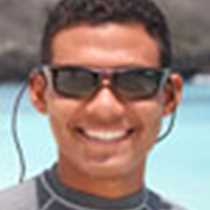Today we left the western islands and headed to Santiago, visiting three different locations to offer the best of everything. This island offers a lot of history due to Charles Darwin’s visit in 1835 during the HMS Beagle’s voyage around the world. Here is where the famous naturalist spent most of his time collecting data before he left, never to return. Santiago had a human settlement for several years during the 1920’s which ran a salt mine that later closed because of the hard living conditions.
We set foot on the island before the sun could come out entirely and walked to a place called Espumilla beach. It was named by the fishermen who, on every journey here, were greeted by the foam of the breaking waves. This beach is one the most popular places for the Pacific green sea turtles to nest at night and that is one of the reasons why we took an early walk. Right after we landed we could identify several tracks from females that finished their nests the night before and went back to the water. Deeper into our walk on the trail we found a lush green forest of incense trees and the top predator on these islands, the Galapagos hawk. The hawk is feared by every animal in the archipelago including hatchling turtles.
Some guests enjoyed kayaking around the shore between Espumilla and the next visitor site.
Later, after we reenergized with breakfast, we headed into the water for snorkeling to find more white tipped sharks, tropical fish and rays.
During the afternoon the National Geographic Islander moved again to Puerto Egas. Here we spent time walking along the shoreline. Several lava tunnels offered good shelter for the Galapagos fur seal to escape the heat. There was a time when the fur seals were hunted for their coat.
The water began to subside and we got to see tidal pools where some species reside, where marine iguanas relaxed and where some fish were trapped, so herons enjoyed an easy meal.
At the end of the day we all enjoy another spectacular sunset in this archipelago.







